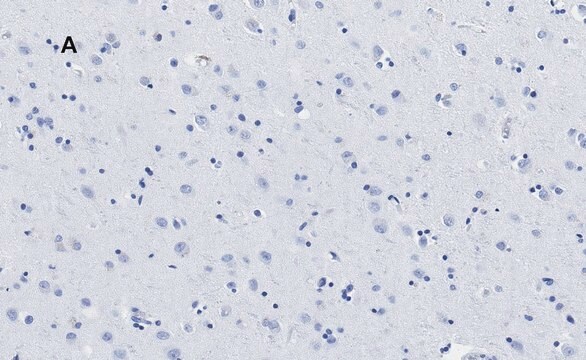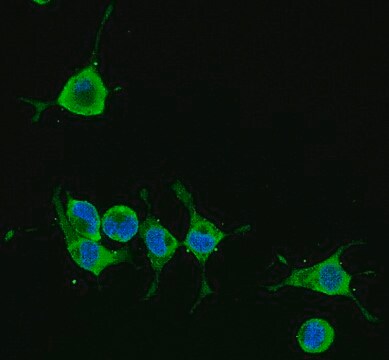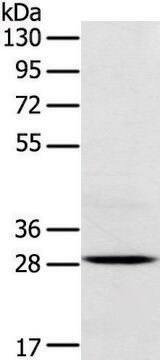ABN1643
Anti-APP Antibody, AEP-cleaved (373N)
serum, from rabbit
Synonym(e):
Amyloid beta A4 protein, 373N fragment, ABPP, 373N fragment, Alzheimer disease amyloid protein, 373N fragment, Amyloid precursor protein, 373N fragment, APP, 373N fragment, APPI, 373N fragment, Cerebral vascular amyloid peptide, 373N fragment, CVAP, 373N
About This Item
Empfohlene Produkte
Biologische Quelle
rabbit
Qualitätsniveau
Antikörperform
serum
Antikörper-Produkttyp
primary antibodies
Klon
polyclonal
Speziesreaktivität
human, mouse
Speziesreaktivität (Voraussage durch Homologie)
porcine (based on 100% sequence homology), nonhuman primates (based on 100% sequence homology), canine (based on 100% sequence homology), guinea pig (based on 100% sequence homology)
Methode(n)
immunohistochemistry: suitable
western blot: suitable
NCBI-Hinterlegungsnummer
UniProt-Hinterlegungsnummer
Versandbedingung
ambient
Posttranslationale Modifikation Target
unmodified
Angaben zum Gen
human ... APP(351)
Allgemeine Beschreibung
Spezifität
Immunogen
Anwendung
Neurowissenschaft
Western Blotting Analysis: A 1:1,000 dilution from a representative lot detected APP N-terminal fragment 373N in brain tissue lysates from 5XFAD familial AD transgenic mice, but not from AEP-knockout 5XFAD mice (Courtesy of Dr. Keqiang Ye, Emory University, U.S.A.).
Western Blotting Analysis: A representative lot detected an increased APP N-terminal fragment 373N in AEP-containing brain fractions from 5-month-old 5XFAD familial AD transgenic mice than wild-type mice (Zhang, Z., et al. (2015). Nat. Commun. 6:8762).
Western Blotting Analysis: A representative lot detected an age-dependent increase brain APP N-terminal fragment 373N in mice. Upregulated APP 373N level was seen in human AD brain samples when compared with age-matched non-AD brains (Zhang, Z., et al. (2015). Nat. Commun. 6:8762).
Western Blotting Analysis: A representative lot detected AEP-cleaved recombinant GST-APP N-terminal fragment, but not the uncleaved GST-APP or the cleaved C-terminal fragment (Zhang, Z., et al. (2015). Nat. Commun. 6:8762).
Western Blotting Analysis: A representative lot detected AEP-cleaved APP N-terminal fragment 373N in untransfected, but not AEP siRNA-transfected, HEK293 cells.
Qualität
Western Blotting Analysis: A 1:1,000 dilution of this antiserum detected APP(1-585), but not APP(1-373) or full-length APP, GST fusion exogenously expressed in HEK293 cells.
Zielbeschreibung
Physikalische Form
Lagerung und Haltbarkeit
Handling Recommendations: Upon receipt and prior to removing the cap, centrifuge the vial and gently mix the solution. Aliquot into microcentrifuge tubes and store at -20°C. Avoid repeated freeze/thaw cycles, which may damage IgG and affect product performance.
Sonstige Hinweise
Haftungsausschluss
Sie haben nicht das passende Produkt gefunden?
Probieren Sie unser Produkt-Auswahlhilfe. aus.
Empfehlung
Lagerklassenschlüssel
12 - Non Combustible Liquids
WGK
WGK 1
Flammpunkt (°F)
Not applicable
Flammpunkt (°C)
Not applicable
Analysenzertifikate (COA)
Suchen Sie nach Analysenzertifikate (COA), indem Sie die Lot-/Chargennummer des Produkts eingeben. Lot- und Chargennummern sind auf dem Produktetikett hinter den Wörtern ‘Lot’ oder ‘Batch’ (Lot oder Charge) zu finden.
Besitzen Sie dieses Produkt bereits?
In der Dokumentenbibliothek finden Sie die Dokumentation zu den Produkten, die Sie kürzlich erworben haben.
Unser Team von Wissenschaftlern verfügt über Erfahrung in allen Forschungsbereichen einschließlich Life Science, Materialwissenschaften, chemischer Synthese, Chromatographie, Analytik und vielen mehr..
Setzen Sie sich mit dem technischen Dienst in Verbindung.








